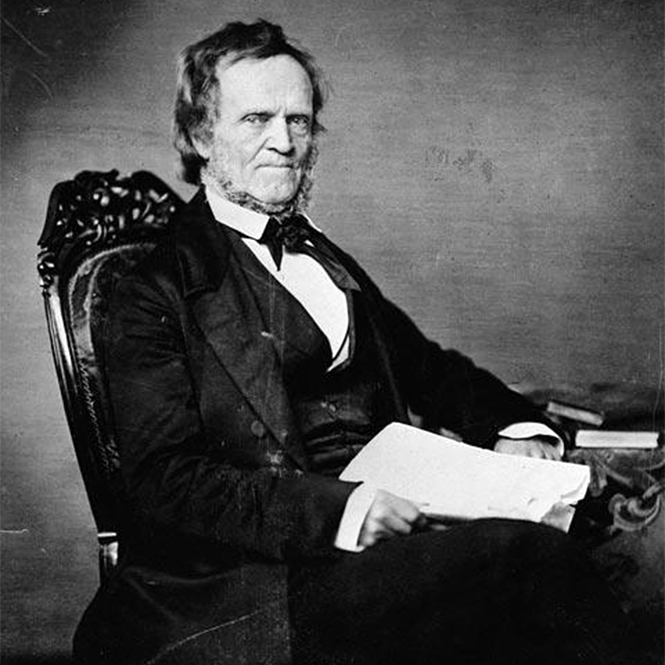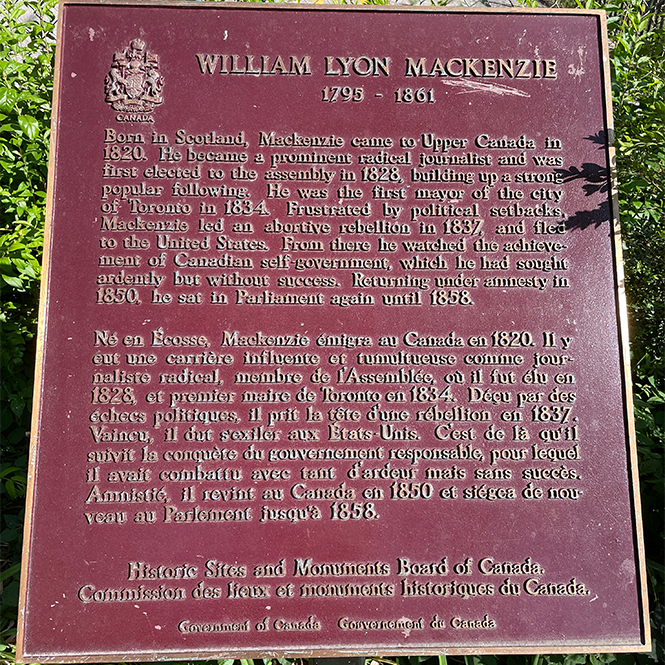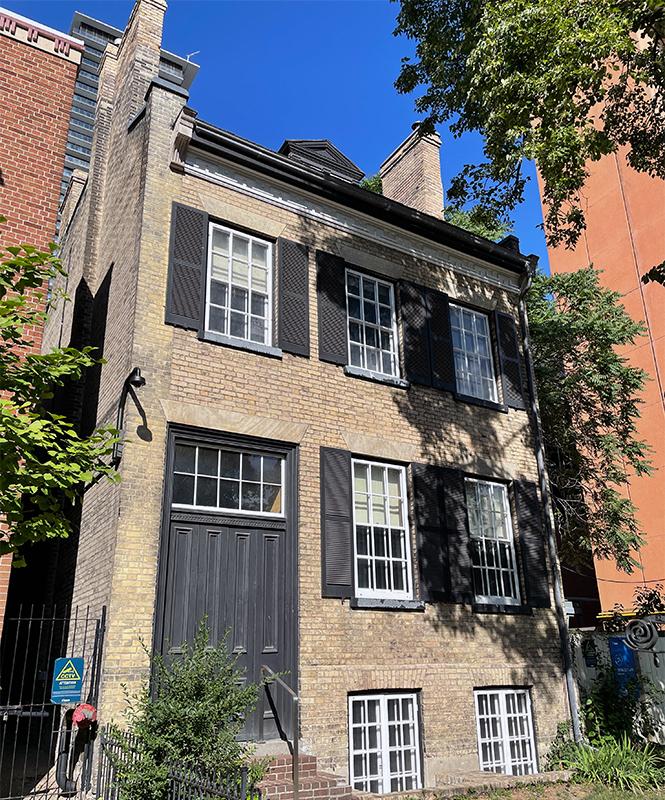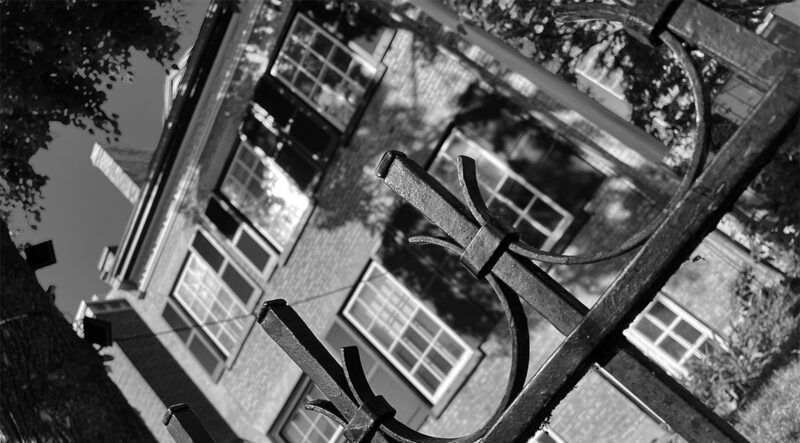A picture has a way of making you feel certain things, but no matter what picture I have seen of the house with the black double four-panel door, it always just looks insidious. Given all of the rumours surrounding the MacKenzie House, others must also get this feeling.
Is there any truth to the ghost stories or were the prior owners just creating chitter to drum up business?
The Firebrand
William Lyon MacKenzie was born March 12, 1795, in Dundee, Scotland and emigrated to Montreal first in 1820 and later in the year moved to York (now Toronto). He became wrapped up in politics upon learning that people were dissatisfied with the Canadian government. In 1824, after moving to Queenston, and purchasing a printing press, he launched his newspaper, The Colonial Advocate.

When he moved back to York in November 1824, his newspaper office was sabotaged. He was awarded damages that he would use to set up an even better office, which led to him becoming the leader of the radical political wing of Ontario.
He was elected to the Upper Canada Legislative Assembly for York three times (1828, 1830 and 1834). He caused political chaos during the 1830s as a Reformer and had been bounced from parliament multiple times, only to return to parliament through by-elections. Every time he was expelled from the legislature because of his disloyalty to the crown (and his ramblings in his newspapers about corruption).
Lieutenant Governor Sir Bond Head appealed to Union Loyalists to vote Tory, explaining that Reformers were advocating for American republicanism. MacKenzie lost his York riding to David William Thomson in the 1836 election.
After one of his expulsions from parliament, which subsequently became a debarment, Mackenzie turned his attention to municipal politics and ran for the newly incorporated City of Toronto.
At this point, MacKenzie was fed up with Upper Canada’s political culture and started the controversial newspaper called the Constitution. He discussed then American President Andrew Jackson and his democratic ideologies. He started to communicate with those who shared his views about a rebellion and due to the economic depression of 1836-37, MacKenzie had increased support. He and 800 supporters made a plan to go to Toronto and seize the governor and set up an interim government. The Upper Canada rebellion was not as organized as the Lower Canada one, and MacKenzie was forced to flee to New York state, where he continued to taunt the Canadian government. He then attempted to rally people at Navy Island. That too would prove fruitless, as the British army forced its collapse in January 1838.
He was found guilty of breaking neutrality laws by the U.S. government and spent eleven months in a Rochester, N.Y. jail before being pardoned. While serving his time, he wrote The Caroline Almanac. In its pages, he wrote about his disappointment in U.S. politics.
The Lyon’s den
MacKenzie was allowed re-entry into Canada in 1849 and won his first electoral bid (a by-election) in 1851. He would represent Haldimand County in the Niagara Region from 1851 to 1858. Poor health forced him to resign from the Legislature.
His supporters gifted him a house in 1859 at 82 Bond Street in Toronto. He would die in the home shortly after. He left behind his wife and three daughters who moved from the house, all while subletting the home until they sold it in 1877.
Bringing it back to its glory

The plaque outside William Lyon
MacKenzie’s house on 82 Bond Street in
Toronto.
In 1936, the house was saved from demolition by William MacKenzie’s grandson, William Lyon MacKenzie King, who became the 10th Prime Minister of Canada. The house was then given to the City of Toronto and received heritage status in 1973.
Conjuring up some business
In 1960, the Toronto Telegram ran a story about two couples — the Dobbans and Edmunds — who were taking care of the house and had encounters with ghosts. They told a sensational story of a haunted museum where they would see the apparition of William Lyon MacKenzie. Additionally, they spoke of a woman with long hair that slapped one of the caretakers. There were also recollections of footsteps and phantom hands playing the piano in the lounge. The kicker was when they discussed an invisible entity making printing press sounds.
They would recant their story and tell the Toronto Daily Star that they made it all up to stir up curiosity and bring in more business. Former caretaker Alex Dobban was told the paper, “There’s nothing to it,” when he was asked about the stories.
Is it currently haunted?

The MacKenzie House is located at 82
Bond Street in Toronto.
If you do a quick google search of MacKenzie’s house, you will find a lot of first-hand encounters. Individuals speak of cold spots and invisible entities walking past them. They still talk about the piano playing and even ghostly footsteps. Some have even reported experiences with ghost children.
I wanted to dig a little deeper into this and I happened upon a short video investigation. The Christian Paranormal Research Society visited the house and conducted their research about the hauntings to see if there was any scientific evidence they could find to support the claims.
During their daytime investigation, they examined many areas using EVP and EMF experiments. They also used holy water for provocation purposes. Nothing seemed to be out of the ordinary. They debunked the printing press noises by pointing to vibrations from the 505 streetcar that passes along Dundas Street East.
The only strange thing that occurred was an abnormal EMF reading near the doorway in the late hours of the evening for unknown reasons. Is that enough evidence to prove something lurks within the MacKenzie house? OCPRS thinks not and talks about the possibility of demonic entities being much more likely.
You decide
The MacKenzie House has a rich history filled with politics, politicians, and ghost stories. But are the ghost stories more than just stories?
Some scientific evidence suggests there is nothing out of the ordinary going on at MacKenzie House but how can you overlook all of the first-hand experiences? Is the power of suggestion that strong or is it just a hoax to drive business to the museum? I guess seeing is believing.

